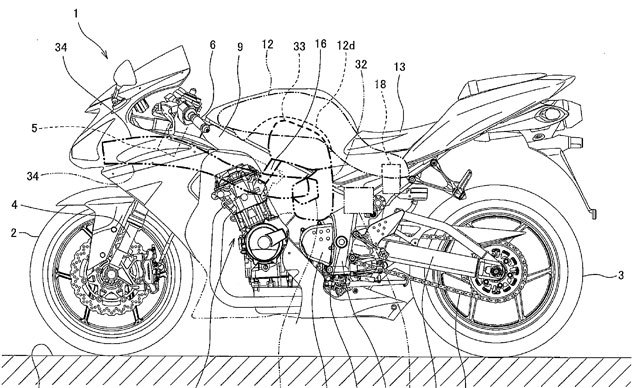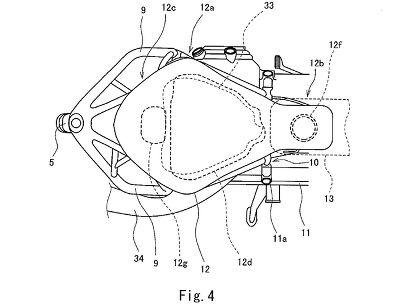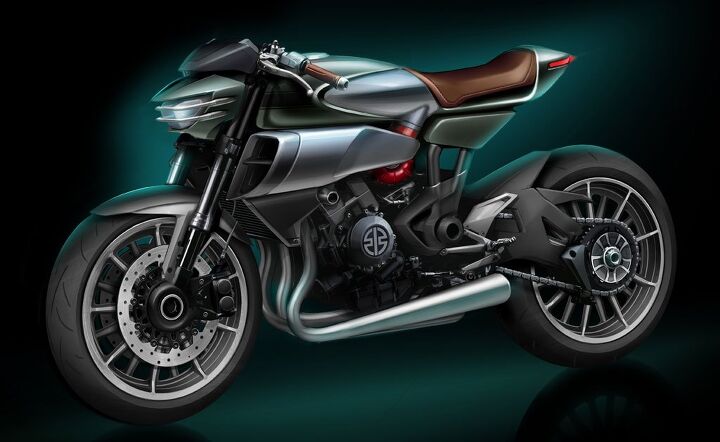Sorry, But This Probably Isn't a Supercharged 600cc Kawasaki R2

A few days ago, some images began floating around reportedly depicting a supercharged 600cc Kawasaki expected to be called the “Ninja R2.” But just like we did last week with a design patent for a 125cc Honda Monkey prototype, we’re going to explain why these reports probably aren’t true.
But before we get there, let’s consider the parts of the story that contain some element of truth. Firstly, we know that Kawasaki is working on more supercharged motorcycles to follow the H2 and H2R. Kawasaki hinted as much, revealing concept sketches of two supercharged models: the café racer-styled SC-01 Spirit Charger and the SC-02 Soul Charger roadster (pictured below). We also know Kawasaki has filed trademarks for the name “Ninja R2.” From this, we can infer that Kawasaki is at least considering a smaller-displacement supercharged sportbike to slot in beside the H2 and H2R.
Last week, British blog Morebikes.co.uk published the diagram seen above, with a fairly over-the-top story using words (in all-caps so you know this is A REALLY BIG DEAL) like “first,” “supercharged,” “all,” “will” and “exclusive.” Morebikes claims these images were received exclusively from Kawasaki’s legal department, lending credence to the story, resulting in other websites all over the world republishing the story without much scrutiny (did we mention Morebikes also used exclamation marks?).
The truth is, these diagrams were from a Kawasaki patent application published by the U.S. Patent and Trademark Office earlier this month that can readily be found by anyone with an internet connection (so much for “exclusive…”).
While the patent does describe a supercharged motorcycle, there is nothing contained within it that specifies that it uses a 600cc engine as Morebikes posits. In fact, patents typically avoid mentioning specific details like that, as the actual engine displacement isn’t important for the purposes of the patent.
The 600cc assumption seems to stem from the illustration sharing some similarities with the ZX-6R. That’s because the picture is of a Ninja ZX-6R, from 2005-2006 to be exact:
The big giveaways are the underseat exhaust and the swingarm design, elements that make this “new” design a decade old. Note too that the patent illustration at the top shows the ZX-6R’s twin-spar frame while other drawings in the patent application illustrate a trellis frame.
Kawasaki likely used the 2005 ZX-6R only for illustrative purposes, probably because the design of an actual motorcycle hadn’t been completed yet. The USPTO patent application is actually a refiling of the original Japanese application under the Patent Cooperation Treaty which streamlines the process of filing patents in multiple countries. While this patent was published by the USPTO this month, the application itself was filed Oct. 3, 2013 in Japan.
Judging from the date of the application filing, the patent is more likely for the H2 and H2R rather than a newer model. The inventors listed on the filing, Hiroshi Ishii, Daisuke Saeki and Tomo Yamamoto, are also credited for other patents resulting in the H2 and H2R’s fairing and chassis designs. Those patents were filed in November 2013, not long after this alleged R2 patent was filed, suggesting they were developed in conjunction.
Based on the evidence at hand, we conclude that that this patent is not for a new supercharged R2 supersport but more likely for the existing H2 and H2R. Key elements of the patent describing the placement of the supercharger and the way part of the fuel tank runs under the seat are also present on the H2, and the patent’s goals of incorporating a supercharger without increasing the size of the motorcycle are just as important for a literbike as it is for a supersport.
As for the R2, Kawasaki is likely still considering it. Judging by the Soul Charger and Spirit Charger sketches, we’ll likely see production models based on those concepts before we see another supercharged sportbike. And when Kawasaki does introduce a Ninja R2, be sure that MO will be lining up to be among the first to test it.

Dennis has been a part of the Motorcycle.com team since 2008, and through his tenure, has developed a firm grasp of industry trends, and a solid sense of what's to come. A bloodhound when it comes to tracking information on new motorcycles, if there's a new model on the horizon, you'll probably hear about it from him first.
More by Dennis Chung



































Comments
Join the conversation
Another thing to remember is that patent applications are published 18 months after filing of the application so the drawings are already a year and a half old by the time these "scoops" are published. The drawings in a patent application are also just illustrations of something that happens to incorporate whatever feature is claimed in the patent and do not have to be something that is ever actually made or represent any real product.
Great sleuthing, DC. I love this MOronic coverage.